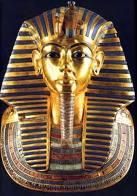Tutankhamun's treasure: what you didn t know
By Zahi Hawass
Carnarvon's widow sold the bulk of the antiquities he had stored at his home, Highclere Castle, to the Metropolitan Museum in New York. Howard Carter was tasked with registering and cataloguing these antiquities which included an alabaster vase, and a portrait of the Egyptian pharaoh Akhenaton. Other artefacts were lent by the Lord's family to both the British Museum and Newbury Museum. There is now a hall full of beautiful statues and antiquities [at Highclere Castle], including the sarcophagus of a noble woman which dates back 3,500 years.
Let me tell you the story of Lord Carnarvon, the man who financed the Tutankhamen tomb excavation. Lord Carnarvon travelled to Egypt for the first time in 1898, following Victor Loret’s discovery of a second crypt to the tomb of King Amenhotep II, in the Valley of the Kings, which was known as tomb KV35. The side chamber was found hidden behind one of the tomb's walls, and this discovery was both a unique and significant event. The fact that 13 mummies were discovered in this tomb, the majority of whom were royalty, is a clear indication that there are a lot of puzzles and secrets surrounding the Pharaohs which archaeologists are determined to solve.
Lord Carnarvon began to spend much of the winter in Egypt since 1906, after physicians advised him to avoid humid weather and live in a dry climate. Egypt was therefore ideal for him, and during his stay he managed to obtain a permit to search for, and excavate, Egyptian antiquities. During the 16 years he spent in Egypt, the majority of the excavations financed by Lord Carnarvon were based in Luxor, the Valley of the Kings, and the Tombs of the Nobles. Lord Carnarvon was known for holding on to the pieces he discovered, as well as purchasing antiquities on the market. As a result, he was able to accumulate one of the largest and most significant private archaeological collections in the world. Some people even believe that his personal collection surpassed that of the British Museum, and I can say that Lord Carnarvon's collection includes many incomparable and unique antiquities.
When Carnarvon met Howard Carter, he was persuaded to finance his search for the missing tomb of a king. He continued to finance this search for four years, however in the fifth year of the search Lord Carnarvon seemed hesitant, and asked Carter to put an end to this project, for he had failed to discover anything. However Carter was determined to continue his search, even if he had to finance it himself. Lord Carnarvon, sensing Carter’s strong determination to continue his search for this tomb in the Valley of the Kings agreed to finance a fifth and final year. To both parties surprise, the tomb of the "Golden Pharaoh" Tutankhamen, was discovered that year.
Lord Carnarvon arrived in Luxor to see this wonderful discovery for himself, accompanied by his daughter Evelyn, who subsequently fell in love with Howard Carter. In order to reveal this stunning archaeological find to the world, Lord Carnarvon granted exclusive publishing rights to the "London Times" newspaper, thus depriving other newspapers of the scoop, in return for a considerable financial sum. Lord Carnarvon and Howard Carter also attempted to gain possession of a percentage of the tomb's unearthed antiquities; however their request was declined because Egyptian law at the time would not allow the division of a tomb’s contents, so long as this tomb was discovered intact. As a result of this, Lord Carnarvon attempted to steal some of the artefacts, but we do not know whether this was done with or without Howard Carter's knowledge.
Lord Carnarvon died just three months after the discovery of Tutankhamen's tomb, and his death sparked widespread talk of the so-called "curse of the Pharaoh" which later provided the inspiration for many Hollywood movies. After he died, his widow sold the bulk of the antiquities he had stored at his home, Highclere Castle, to the Metropolitan Museum in New York. Howard Carter was tasked with registering and cataloguing these antiquities, and he later announced that he had left some ‘insignificant’ items at Highclere Castle. Yet this was not true, as these items included, for instance, an alabaster vase, and a portrait of the Egyptian pharaoh Akhenaton, which are both extremely valuable pieces. There were also other artefacts which the Lord's family lent to both the British Museum and Newbury Museum. There is now a hall full of beautiful statues and antiquities [at Highclere Castle], including the sarcophagus of a noble woman which dates back 3,500 years.
I believe that the battle between us and the family of Lord Carnarvon has now begun over the return of these antiquities to Egypt, and I do not believe that Lord Carnarvon’s grandson can prove that they were taken from Egypt legally.
Source: Asharq Al-Awsat, 10/01/11
- Συνδεθείτε για να υποβάλετε σχόλια
 Εκτυπώσιμη μορφή
Εκτυπώσιμη μορφή- Send by email

